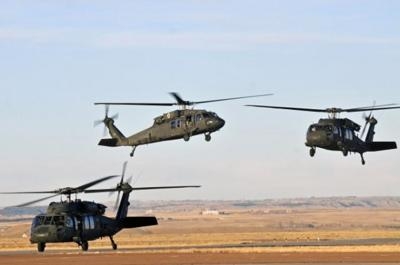Mon, Jul 22, 2013
Looks Ahead To All-Composite Construction Of Army Aircraft
In the future, Army aircraft may be made of all composite materials, and the Prototype Integration Facility Advanced Composites Laboratory is ready. Part of the Aviation and Missile Research Development and Engineering Center's, or AMRDEC's, Engineering Directorate, the Prototype Integration Facility's, PIF's, Advanced Composites Lab has successfully designed and made repairs on damaged composite aircraft components for several years now.

From research and development to implementation and rapid prototyping, advancing composites technology is one of AMRDEC's core competencies that enable the current and future force. The PIF Advanced Composites Lab is one of several teams at the AMRDEC working with composites. "We have gotten as strong and as light as we can get with metals, and we're at the end of what metals can economically do," PIF Advanced Composites Lab lead Kimberly Cockrell said. "The only way to get stronger and lighter and more capable for the fight is to go to composites."
PIF leadership recognized a need for advanced composites repair and began developing a composites capability within the PIF mission to provide rapid response solutions to the warfighter. The program includes repair design and engineering substantiation to show that repaired components are returned to original strength.
Personnel in the PIF Advanced Composites Lab designed and developed repairs for damaged composite stabilators on the UH-60M Black Hawk helicopter and the AH-64E Apache helicopter. Prior to their repair method, the only way to repair an aircraft with a damaged stabilator was to pull off the broken stabilator and replace it with a new one. Cockrell said the "pull-and-replace" approach was costing the Army up to six figures per stabilator replacement. While the first repair procedures were designed for Black Hawk stabilators, the repair method applies to any solid laminate or sandwich core composite structure, so the procedures and training can be leveraged to other Army aircraft.

Cockrell is proud of the lab's achievements. Its repair procedures are the first approved repair for primary composite structure on Army aircraft. The lab is currently working repairs for blades too, as well as just-in-time tooling for parts with complex curves or topography.
And in addition to repair solutions, the lab is using composite materials to create solutions for other issues. For example, it has designed and built a composite doubler to strengthen the hat channels that extend from the hinges of the UH-60 engine cowling. "When the aircraft is on the ground being maintained, the engine cowling folds out to become a maintenance stand," Cockrell explained. "Two Soldiers can stand up there with a tool box and work on the engine. Unfortunately, minor damage to those hat channels can cause these (cowlings) to catastrophically fail and seriously injure the Soldiers. We designed this piece so that -- if the hat channel shows any kind of damage whatsoever -- you can simply install this doubler over the damaged area; it will restore the cowling to its original strength or better, and two doublers -- one on each side of the cowling -- adds less than a pound to the overall aircraft weight," Cockrell continued. "So the pound that you add is well-worth the safety margin you
gain."
It's concepts like that, Cockrell said, that the lab is introducing to program managers to show how the lab can help with more than just repairing stabilators. "In five to 10 years, it's all composite," he said. "So whether it's fiberglass or carbon fiber or Kevlar or a hybrid, it's going all composite quickly. And it's important for the Army to be ready."
More News
Airbus Racer Demonstrator Makes Inaugural Flight Airbus Helicopters' ambitious Racer demonstrator has achieved its inaugural flight as part of the Clean Sky 2 initiative, a corners>[...]
A little Bit Quieter, Said Testers, But in the End it's Still a DA40 Diamond Aircraft recently completed a little pilot project with Lufthansa Aviation Training, putting a pair of >[...]
Line Up And Wait (LUAW) Used by ATC to inform a pilot to taxi onto the departure runway to line up and wait. It is not authorization for takeoff. It is used when takeoff clearance >[...]
Contributing To The Accident Was The Pilot’s Use Of Methamphetamine... Analysis: The pilot departed on a local flight to perform low-altitude maneuvers in a nearby desert val>[...]
From 2015 (YouTube Version): Overcoming Obstacles To Achieve Their Dreams… At EAA AirVenture 2015, FedEx arrived with one of their Airbus freight-hauling aircraft and placed>[...]
 Airbus Racer Helicopter Demonstrator First Flight Part of Clean Sky 2 Initiative
Airbus Racer Helicopter Demonstrator First Flight Part of Clean Sky 2 Initiative Diamond's Electric DA40 Finds Fans at Dübendorf
Diamond's Electric DA40 Finds Fans at Dübendorf ANN's Daily Aero-Term (04.23.24): Line Up And Wait (LUAW)
ANN's Daily Aero-Term (04.23.24): Line Up And Wait (LUAW) NTSB Final Report: Extra Flugzeugbau GMBH EA300/L
NTSB Final Report: Extra Flugzeugbau GMBH EA300/L Classic Aero-TV: 'Never Give Up' - Advice From Two of FedEx's Female Captains
Classic Aero-TV: 'Never Give Up' - Advice From Two of FedEx's Female Captains




